The
Desert Express was designed and built in Namibia. A brochure I picked up in the station indicated that it took 250,000 man hours over 18 months to construct. Old coaches from the South African Railways were completely stripped and rebuilt. Wherever possible, Namibian products, skills and materials were used. The end result is impressive both inside and out.
The entire train consists of nine cars and one engine. The cars are painted creamy white offset by an attractive ochre and blue livery with a gray roof. The colors of the Namibian desert. Most of the cars bear names of Namibian wildlife or geographical features. Following is the line up behind the single engine:
Rhino: Power car and storage
Starview: Bistro Bar
Stardune: Function/Conference venue
Welwitschia: Restaurant
Spitzkoppe: Lounge and Bar
Meerkat: Sleeper
Springbok: Sleeper
Oryx: Sleeper
Kokerboom: Sleeper
This is a fixed consist, regardless of the trip. That is to say that there are no other cars. Since the
Desert Express does not operate a daily schedule, there is no need for more than a single train. By comparison, there were five separate
California Zephyrs built in order to accommodate the daily service along the two day journey between Chicago and San Francisco.
Boarding was called at 2:30pm. Although I’ve generally never been in a big hurry to board an airplane so I can sit down and/or get out of the way of one hundred or more fellow passengers, I wasted no time heading out onto the platform and stepping aboard my car. As I mentioned earlier, the cars are all named with the name painted prominently above the windows in the middle of the car. My car, Oryx, was named after a type of African antelope. At the door to greet me was Michelle, a pretty Namibian girl with lively eyes and a nice smile. She welcomed me warmly and directed me down the carpeted hallway to my room.
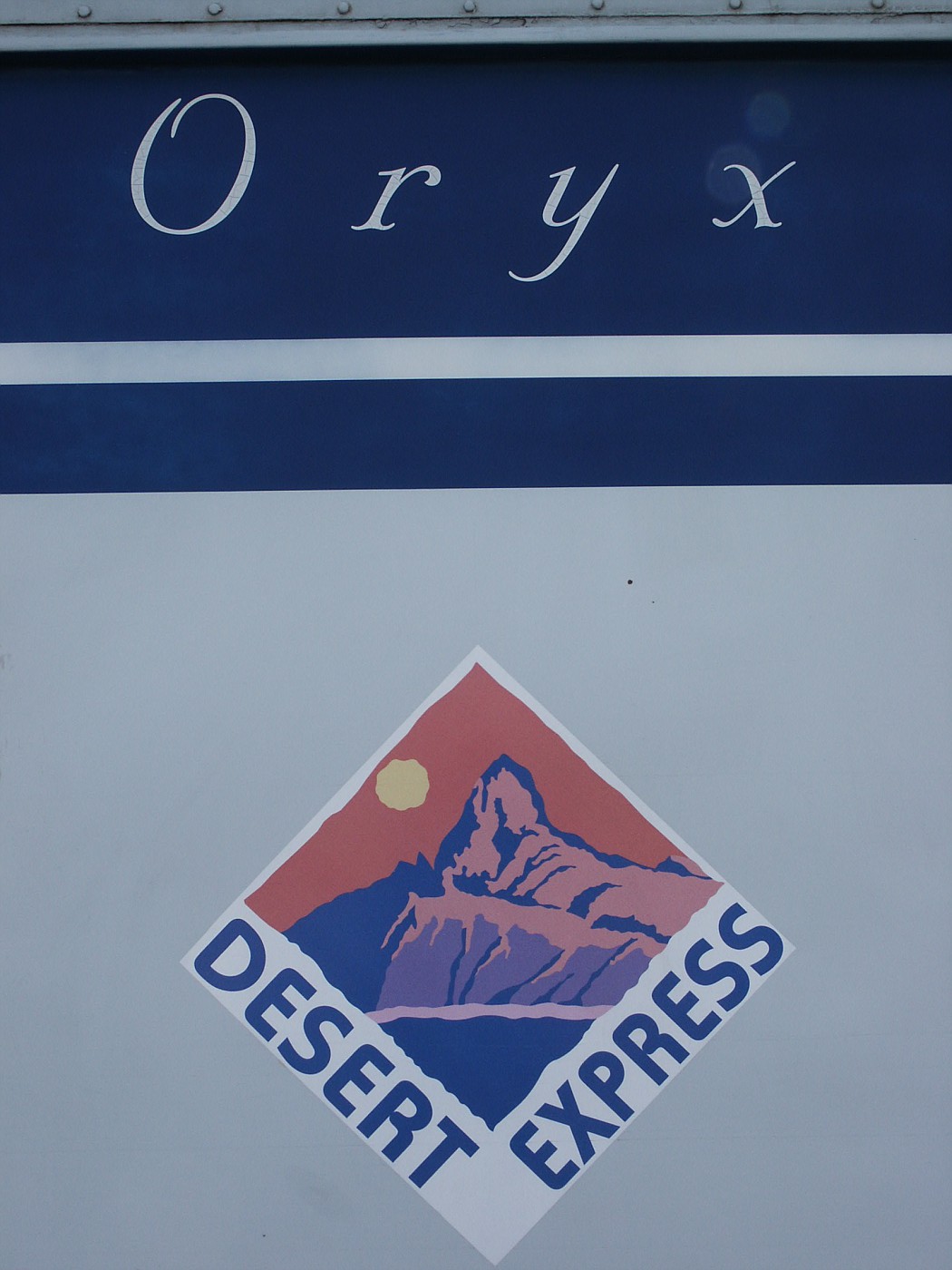 My car and the Desert Express logo
My car and the Desert Express logo
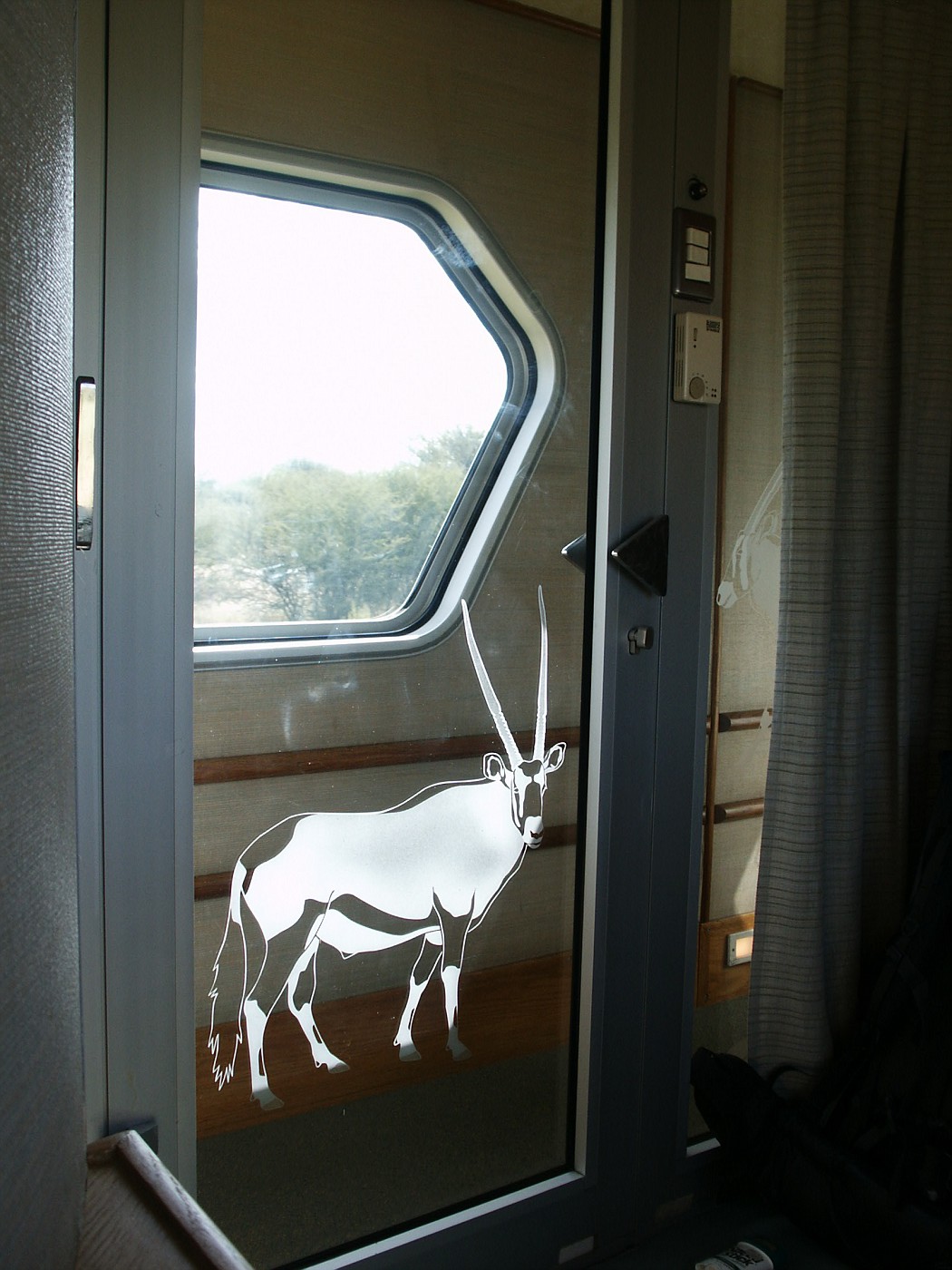 The doorway to my suite has an oryx etched into the glass
The doorway to my suite has an oryx etched into the glass
As a single traveler, I’d expected something like a nice roomette. Instead, I was thrilled to discover that each sleeper consisted of six suites. There are no single roomette type accommodations on the
Desert Express. Single travelers get the same big suite that a couple traveling together would get. I’d seen a couple of them through their glass doors as I walked down the corridor. Each of the suites reflected the name of the coach it was located in with an etched drawing of the animal or bird on the glass door. Very nice. Now, was this train air conditioned? It sure was hot in the hallway!
Locating my suite, I turned the key which had been left in the door and . . . Wow! What a magnificent room! Decorated in tan, beige and brown earth tones, the suite featured a large daytime sitting area with two nicely padded chairs along one wall facing a single chair on the other wall. Between them, below the large window, was a small wooden table. Above the window was a large sand painting of an oryx. Rich golden-red native wood used on the walls complimented the room beautifully. The ensuite bathroom was cleverly designed to make maximum use of minimum space. It featured a complete shower, a large sink that swiveled out of the way of either the shower or the toilet, a large mirror, electric outlets and a hairdryer on request. Amenities such as body wash/shampoo, body lotion, shoe buff and a mending kit were provided in a small kit. Add to this a wall mounted telephone to order room service, a safe for valuables and plenty of reading lights and I’d have to say that this was by far the nicest train compartment I had ever been in, much less seen! And – it was blissfully air conditioned! A thermostat on the wall indicated the temperature had been set at 15 C.
 The Desert Express Suite
The Desert Express Suite
 The Desert Express Suite
The Desert Express Suite
 The Desert Express Suite
The Desert Express Suite
My backpack and daypack had been neatly placed in one corner. After sitting down in one of the cushioned chairs and taking a brief and enjoyable stock of my present lot in life, I retrieved my camera from my daypack and headed back out onto the platform to take some pictures of the train and the station. A few of my fellow passengers were doing the same while others chatted amiably with friends and acquaintances who were either traveling with them or seeing them off. The load was light for today’s run out to the coast - only about half the train was booked.
Stepping back onboard the train, I wandered up to check out the bar and restaurant cars. The bar car was named “
Spitzkoppe” after one of Namibia’s more impressive looking peaks. At one end was an attractive wrap around bar that featured a full bar service including a number of exotic sounding cocktails. There were separate smoking and non-smoking sections with low coach and chair seating areas offset by nice looking wooden cocktail tables. On one of these tables was a unique chess table where I was told that the black and white squares had been made from the sand of the Namib Desert. Finally, two or three coffee table books about Namibia and Namibian wildlife had been strategically placed throughout the lounge. Nature videos, reading material and board games were also available. Very nice. I took a couple of pictures and moved on to the dining car. Better to get these pictures now than to disturb people with the camera’s flash once we were underway.
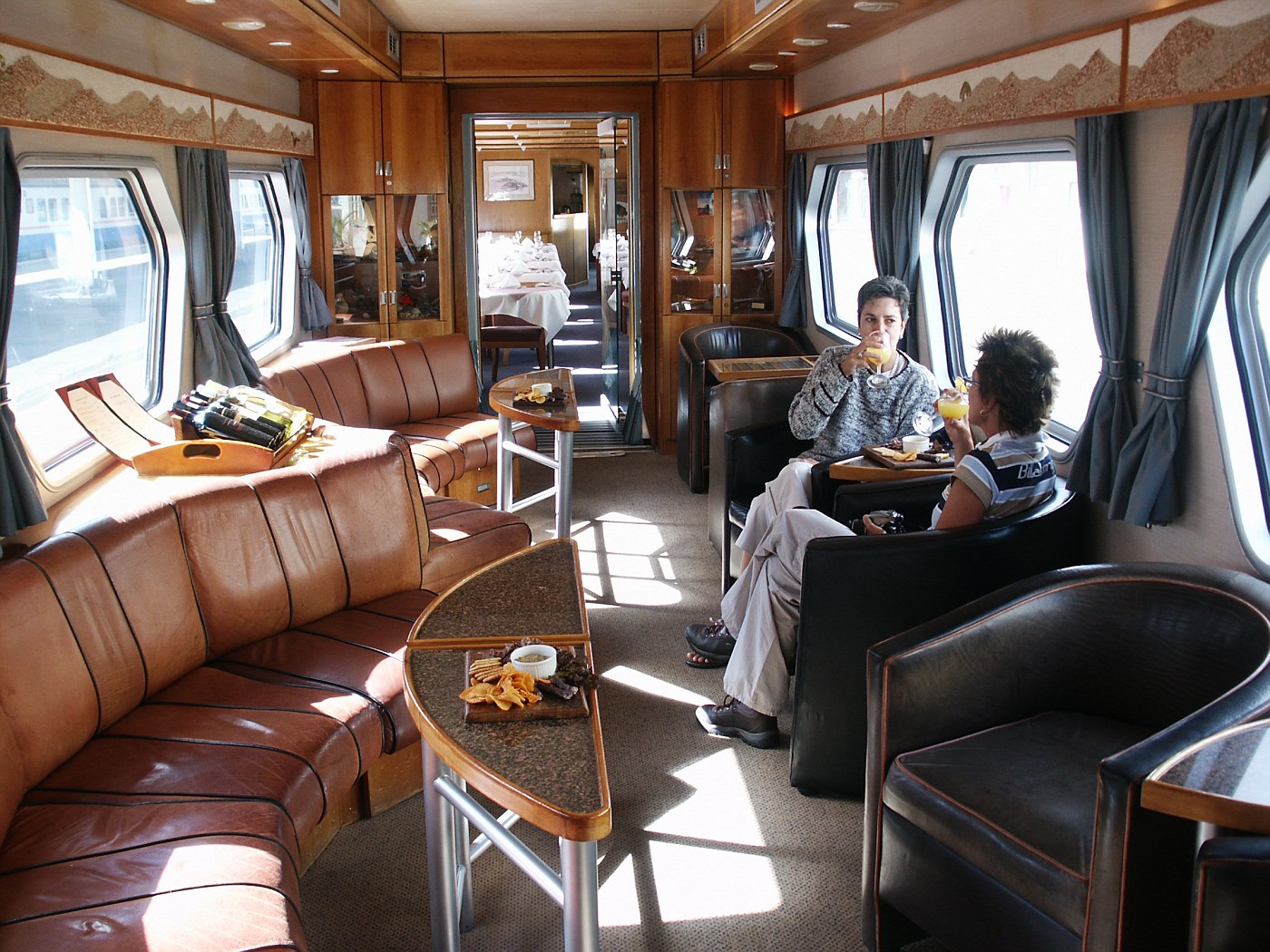 The Desert Express Spitzkoppe Bar
The Desert Express Spitzkoppe Bar
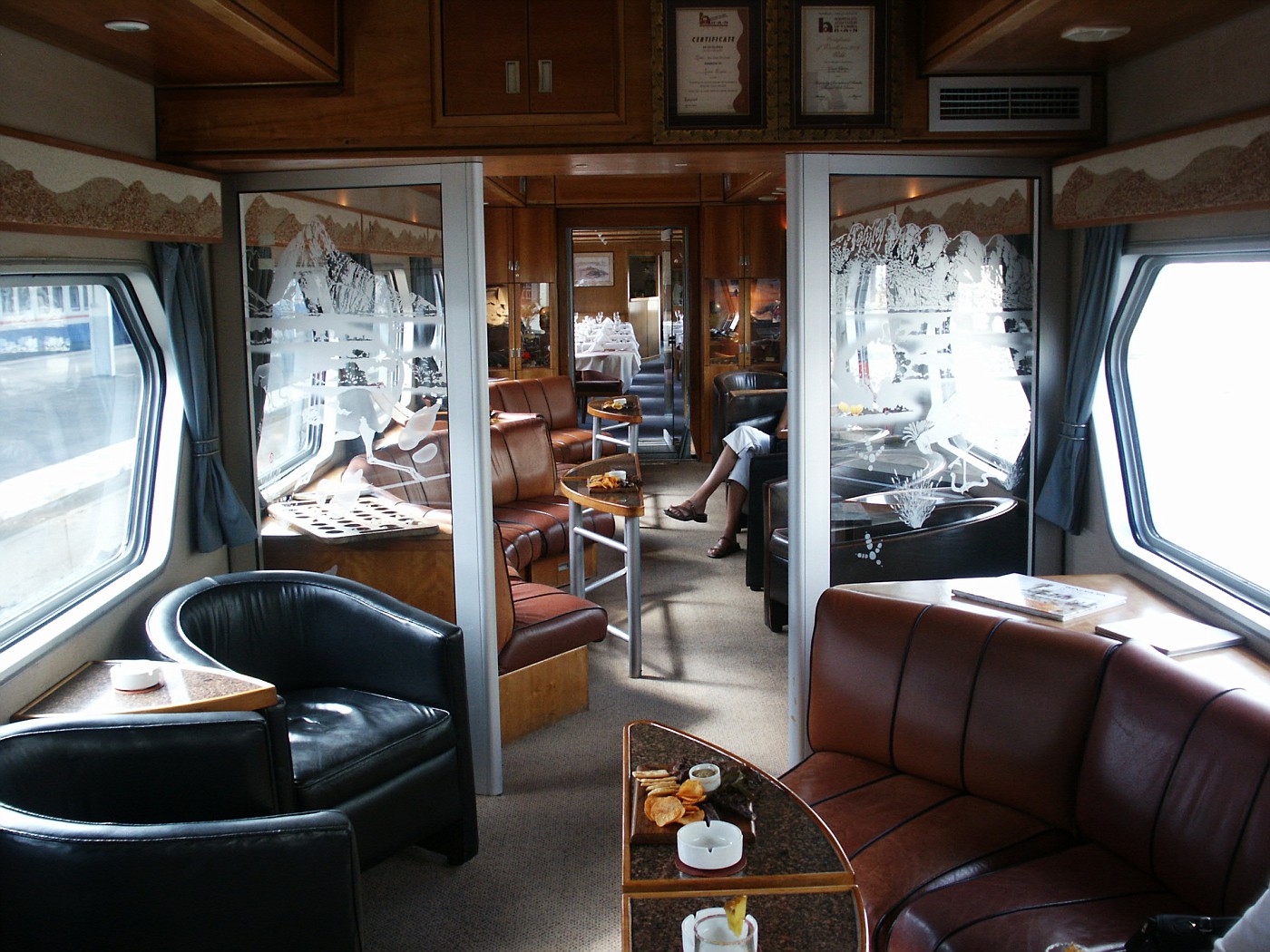 The Desert Express Spitzkoppe Bar
The Desert Express Spitzkoppe Bar
The Welwitschia Restaurant, located adjacent to the Spitzkoppe Lounge, offered spacious seating for thirty via five rows of tables seating four on one side and two on the other. Since the
Desert Express was designed to carry only about fifty passengers, the thirty seat restaurant car was more than sufficient to enable everyone to eat in only two sittings. The overhead lights in the car highlighted sandblasted glass panels depicting animal footprints while stylish glass enclosed candles graced each table.
 The Desert Express Welwitschia Restaurant
The Desert Express Welwitschia Restaurant
 The Desert Express Welwitschia Restaurant
The Desert Express Welwitschia Restaurant
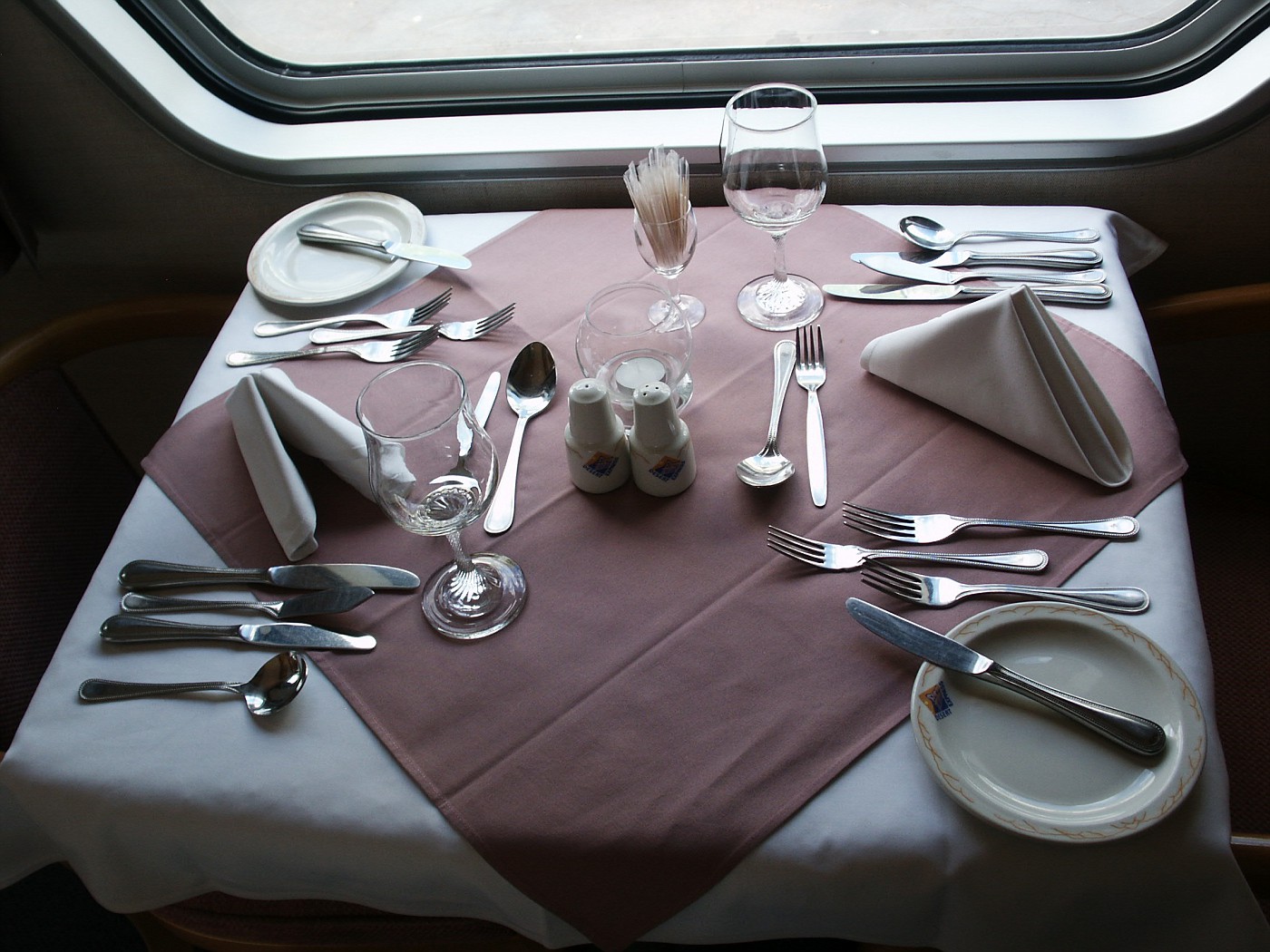 Welwitschia Restaurant Table Setting
Welwitschia Restaurant Table Setting
Back in the Spitzkoppe Lounge, a number of people had gathered for complimentary welcome aboard cocktails and beer. I was happy to see beer offered since I’m not much of a cocktail drinker. Although this would have been a good time to get acquainted with some of my fellow passengers, it appeared that I was the only North American and native English speaker aboard. Alas, my reasonable Spanish and minimal Navaho skills were of no use to me here. German and Afrikaans were the language of the day so I maintained a demure countenance and quaffed my deliciously chilled pint of Windhoek Lager while taking it all in from the corner of the bar. On each table were platters of hors d’oeuvres with biltong, sausage, crackers, chips and a delicious mustard based dip to munch upon. For those of you unfamiliar with southern African cuisine, biltong is a type of jerky made from who knows what kind of beast. I tried some. Like jerky, I had to chew hard and snap my head back to get it down. I decided to stick with the sausage, crackers and chips after just one try.
A sudden jolt indicated that we were underway. There were no whistles, bells or dramatic announcements. I glanced at my watch and noted with some satisfaction that one, I was onboard, and two, that our departure was right on time.
After about ten minutes, our Director of Onboard Services introduced herself and began to orient us as to the services available onboard the train as well as the dinner and breakfast times. The Stardune car, which served primarily as a private conference car, would not be open. However, the Starview Bistro would be open after the second dinner seating. This car featured glass panels in the roof that allowed one to better view the stars above. Interestingly, drinks would only be available in the Spitzkoppe Lounge though we’d be welcome to take them up to the Starview Bistro.
She went on to explain about a couple of side trips which I’ll detail later in this report. We were wished a pleasant journey and I requested another pint of beer. This time I had to pay for it, though. $10.00 Namibian. Relax! That’s about $1.40 US! I chatted briefly with the bartender, a nice kid from Windhoek who spoke flawless English. He’d been working on the
Desert Express for about half a year but soon would be returning to college to complete his studies in engineering. Not a bad job between semesters!
Our journey initially took us north out of Windhoek. We cleared the city suburbs quickly and soon were traveling through desert scrub and mountains that reminded me a lot of the landscape to the north and west of Phoenix. Since the area I refer to, which includes Cave Creek and Carefree is all built up now, that would be Phoenix in the 1950s.
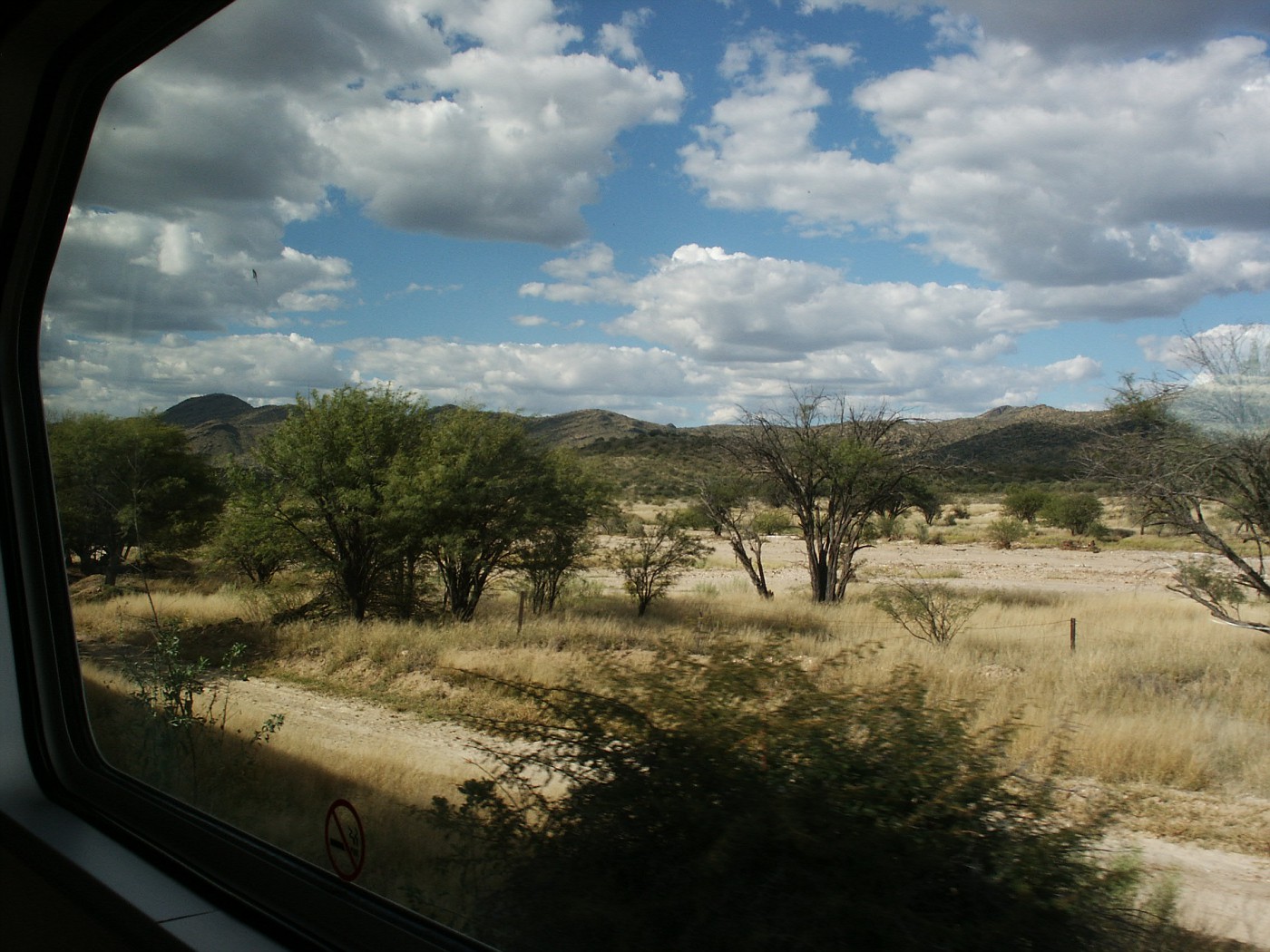 The scenery north of Windhoek
The scenery north of Windhoek
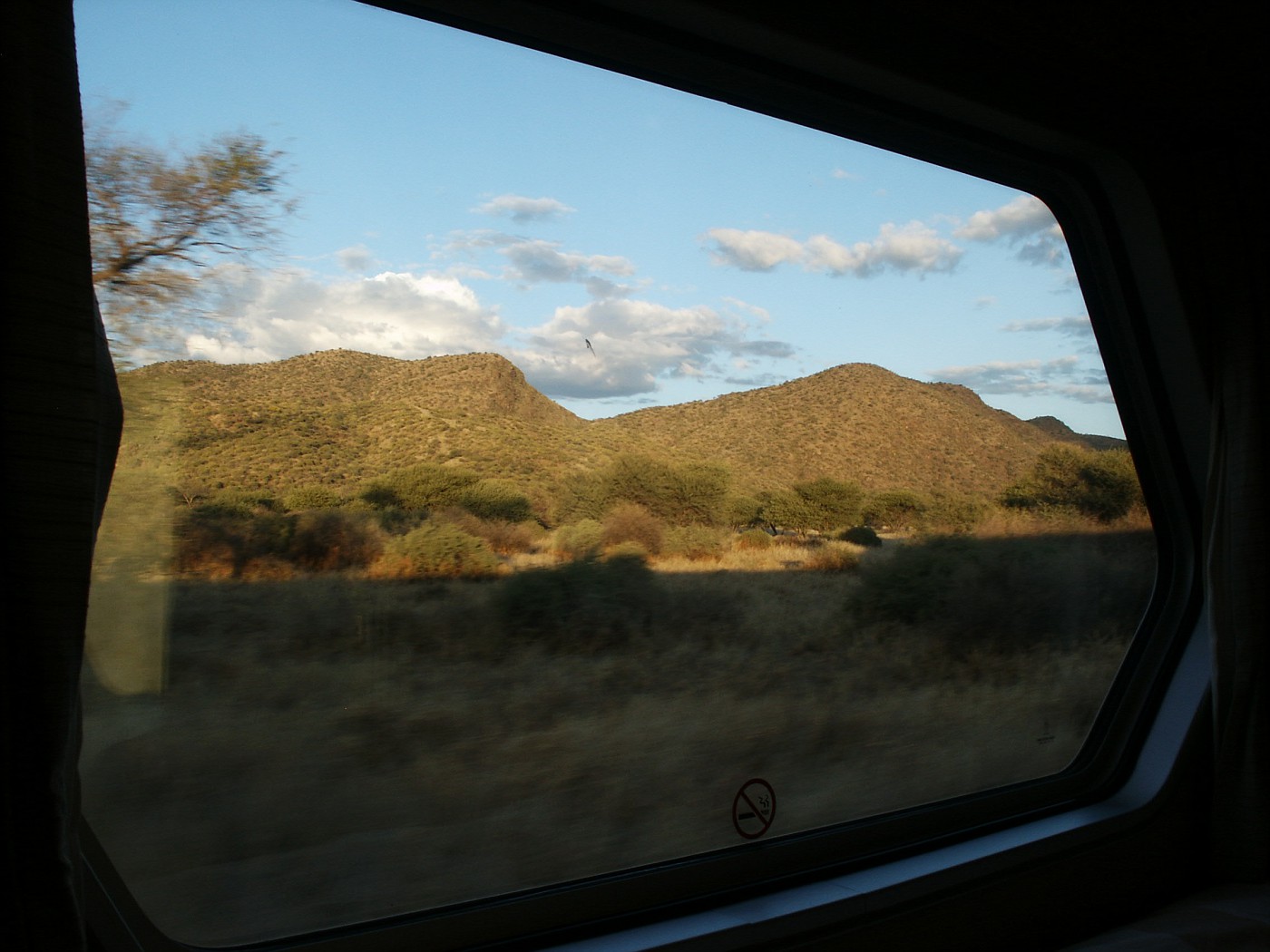 The scenery north of Windhoek
The scenery north of Windhoek
The train rolled along at a very leisurely pace. That’s a nice way of saying that although our destination of Swakopmund was only 381 km (about 230 miles) away, it would take us 19 hours to get there. Mind you, nobody was complaining because all of us were on this train for the experience far more so than the mere transport. Indeed, I would have happy had this trip taken two or three days.
If you divide 19 hours into 381 kilometers, you get an average speed of 20 km or 12 miles per hour. That would be ridiculously slow, so it’s worth noting that not all of the trip is spent in motion. Besides making two stops for off train activities, we’d also be parking on a siding between 11:00pm and 5:00am.